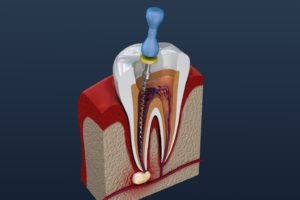
Root canal therapy is consistently successful. Often, it can restore the function of a damaged tooth for a lifetime. In some cases, though, a patient learns that a previous root canal must be redone. If that ever happens to you, you may understandably be concerned. This blog post discusses why endodontic retreatment is sometimes necessary and what you can expect during the procedure.
Reasons for Root Canal Retreatment
Two of the most common reasons for root canal retreatment include:
- A tooth has complex anatomy. Root canal therapy can be tricky. It can be difficult, perhaps impossible, for your dentist to see and access all the little nooks and crannies inside your tooth. Therefore, if there is anything unusual or particularly complex about your tooth’s anatomy, an initial root canal treatment may not be as thorough as it should be. Keep in mind that this does not happen frequently. Dentists who perform root canal therapy are extremely skilled, and most of the time, the treatment is successful the first time around.
- The tooth has incurred further damage. In the majority of cases, a crown should be placed soon after root canal therapy. If crown placement is postponed for any reason, bacteria may sneak into the tooth and create a new infection. Similarly, if an existing crown is damaged or does not fit well, bacteria may have an opportunity to cause problems.
The need for endodontic retreatment can arise fairly soon after the original procedure. However, it is also possible that retreatment will not be necessary for several years or even decades.
What to Expect During Root Canal Retreatment
Depending on the specific details of your case, your general dentist may perform your endodontic retreatment. However, if there are some especially complicating factors, you might be referred to a type of specialist known as an endodontist. In either case, you can be sure that the team who is handling your treatment has all the skills and knowledge necessary to take excellent care of you.
In most ways, your second root canal will be like your first. Your dentist will remove infected tissue from your tooth’s interior before filling it in with a material known as gutta-percha. Later, you should get a crown to protect the treated tooth.
The biggest difference between an initial root canal and endodontic retreatment is that retreatment tends to take longer. This is because your dentist will have to remove the gutta-percha from your first procedure before they can access your tooth’s interior.
You can expect your dental team to make you comfortable during your procedure. Local anesthesia, possibly combined with sedation, can make sure that you feel little to nothing throughout your appointment. When you go home, you may experience some discomfort and soreness. However, it will not be long before your mouth is feeling normal again.
Root canal retreatment may seem like a scary prospect, but it is nothing to be afraid of. Your dentist will do all they can to help you enjoy a smooth and successful procedure.
Meet the Practice
Dr. Olga Kandov is a highly experienced, highly accomplished dentist in Doylestown. She offers root canal therapy and endodontic retreatment in a welcoming and comfortable environment. To learn more about her and how our practice may be able to serve you, contact us at 215-345-6500.